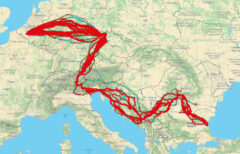This page contains information about the 2020 and 2021 Transcontinental Races, which were each originally called TCR No. 8, but were each cancelled due to the disruption of the Coronavirus pandemic. In 2022, TCR No. 8 finally went ahead. See the Overview page for a general introduction to the Transcontinental Race (TCR). See also the official TCR page.
Timeline and Cancellation
Rough details of the original 2020 TCR were announced at a launch event at Look Mum No Hands in London, UK in late November, 2019. Registration was open for two weeks in November-December, 2019. Applicants were informed in early January 2020 whether they had been awarded a place and the event was scheduled to start near the end of July. Travel restrictions and lockdowns started throughout Europe in early to mid March 2020 and before the end of March the organizers announced that the 2020 TCR was being postponed for a year.
In late December 2020, details of the 2021 replacement event were announced with the new route minimizing the number of border crossings and remaining within the Schengen region to maximize the chance of the race happening with minimum disruption while still crossing a large portion of the continent. People who had accepted a place for the 2020 event were offered a place for the replacement event and no new applications were accepted. Continued uncertainties concerning international travel caused the organizers to cancel the 2021 event in late May 2021.

2020 Planned Route
The start and finish locations from TCR No. 7 were to be used again in the 2020 TCR, but the direction would be reverted back to the traditional west to east format. The total distance was expected to be similar to the longest ever TCR in 2015 of about 4,200 km. However, the amount of climbing would have been significantly more than in 2015 at over 40,000 m. The finish party was planned for the end of Day 15.
The 4 control points were as follows, and are marked on the map below.
- CP1: Roubaix, France. The parcours included some of the classic secteurs of incredibly rough, cobbled farm roads in northern France that are used in the Paris-Roubaix professional bike race every Spring.
- CP2: Grosser Speikkogel, Austria. The parcours involved one of the hardest paved climbs in the Alps with an average gradient of around 11% for at least 10 km. There was then a traverse along a ridgetop gravel road.
- CP3: Durmitor massif, Montenegro. CP3 would have re-visited this stunning National Park in remembrance of the race’s founder Mike Hall because he chose it as CP4 for Transcontinental Race No. 4, 2016. Racers would have passed through the dramatic Tara river gorge and then climbed over the remote, high mountains on a minor paved road.
- CP4: Transalpina, Romania. The race would have visited a high pass in Romania’s Carpathian mountains for the second time (the more famous Transfagarasan Pass featured in Transcontinental Race No. 5, 2017). This time it would have been the Transalpina road, but the parcours actually focused on a lengthy gravel/unpaved side-road.
The start location and CP1 were to be retained in the, subsequently cancelled, 2021 version below. For the 2022 edition, which did go ahead, CP3, CP4 and the finish location were retained.
2021 Planned Route
The start location and CP1 remained the same for the 2021 version of the route, but the rest of the route was changed to minimize the number of countries visited, with only France, Italy and Greece included. The new finish location was in Thessaloniki, Greece. To get from southern Italy to northern Greece, riders would have taken a ferry across the Adriatic Sea, which had been an option in the 2013, ’14 and ’15 races, but had not been allowed since.
With the Roubaix cobbles being retained as CP1, the 3 new control points were:
- CP2: Little St Bernard Pass (Col du Petit St Bernard / Colle del Piccolo San Bernardo), France/Italy. This paved pass connects the Isère valley in France with the Aosta valley in Italy. The parcours also included the Colle San Carlo.
- CP3: Bocchetta di Forcola & Pedenolo, Italy. The parcours mostly followed a small gravel track that went over what would have been the highest altitude pass in TCR history. At 2,768 m above sea level, the Bocchetta di Forcola is about 11 meter higher than the nearby Stelvio Pass that was used in TCRs No. 1 and 2.
- CP4: Gli Appennini, Italy. A 150 km-long parcours with more than 3,000 metres of climbing on minor roads in the Appennine mountains in central Italy.
None of the locations planned for the 2021 race were retained for the 2022 version, but the finish in Thessaloniki, Greece was used in TCR No. 9 in 2023.
Last significant page update: February, 2023
This page is in the The Transcontinental Race section. The next page in this section is:

